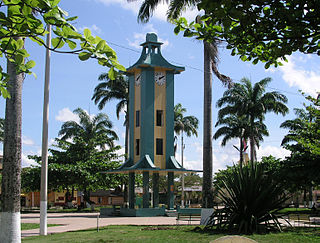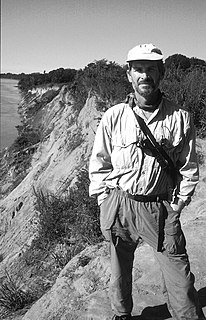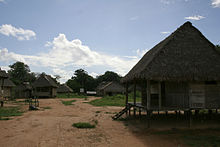
Madre de Dios is a department and region in southeastern Peru, bordering Brazil, Bolivia and the Peruvian departments of Puno, Cusco and Ucayali, in the Amazon Basin. Its capital is the city of Puerto Maldonado. It is also the third largest department in Peru, after Ucayali and Loreto. However, it is also the least densely populated department in Peru, as well as its least populous department.

The Madre de Dios River is a river shared by Bolivia and Peru which is homonymous to the Peruvian region it runs through. On Bolivian territory it receives the Beni River, close to the town of Riberalta, which later joins with the Mamore River to become the Madeira River after the confluence. The Madeira is a tributary to the Amazon River.

Puerto Maldonado is a city in southeastern Peru in the Amazon rainforest 55 kilometres (34 mi) west of the Bolivian border, located at the confluence of the Tambopata and Madre de Dios rivers. The latter river joins the Madeira River as a tributary of the Amazon. This city is the capital of the Madre de Dios Region.
Ch'unchu or Chuncho is a derogatory word used in the Quechua and Aymara languages of Peru for native peoples of the Peruvian Amazon.

Pano-Tacanan is a proposed family of languages spoken in Peru, western Brazil, Bolivia and northern Paraguay. There are two close-knit branches, Panoan and Tacanan, with 33 languages. There are lexical and grammatical similarities between the two branches, but it has not yet been demonstrated that these are genetic.

Tacanan is a family of languages spoken in Bolivia, with Ese’ejja also spoken in Peru. It may be related to the Panoan languages. Many of the languages are endangered.

Madidi is a national park in the upper Amazon river basin in Bolivia. Established in 1995, it has an area of 18,958 square kilometres, and, along with the nearby protected areas Manuripi-Heath, Apolobamba, and the Manu Biosphere Reserve, Madidi is part of one of the largest protected areas in the world.

Tambopata National Reserve is a Peruvian nature reserve located in the southeastern region of Madre de Dios. It was established on September 4, 2000, by decree of President Alberto Fujimori. The reserve protects several ecosystems of the tropical rainforest for the preservation of such forest and the sustainable use of forest resources by the peoples around the reserve.

The Mojeños, also known as Moxeños, Moxos, or Mojos, are an indigenous people of Bolivia. They lived in south central Beni Department, on both banks of the Mamore River, and on the marshy plains to its west, known as the Llanos de Mojos. The Mamore is a tributary to the Madeira River in northern Bolivia.
The Bala Gorge in Bolivia is where the Beni River breaks through the Bala Mountain Range about 12 kilometres south of Rurrenabaque in Bolivia..
Ese Ejja, also known as Tiatinagua (Tatinawa), is a Tacanan language of Bolivia and Peru. It is spoken by Ese Ejja people of all ages. Dialects are Guacanawa (Guarayo/Huarayo), Baguaja, Echoja, and possibly extinct Chama, Chuncho, Huanayo, Kinaki, and Mohino. Chunene is "similar" to Ese Ejja, though whether a dialect or a separate language is not clear.

Bolivians are people identified with the country of Bolivia. This connection may be residential, legal, historical or cultural. For most Bolivians, several of these connections exist and are collectively the source of their being Bolivian.
The Machinere are an indigenous people of Brazil, Bolivia, and Peru. They live along the Acre River in Bolivia. In Brazil they mostly live in the Mamoadate Indigenous Territory, although some live in the Chico Mendes Extractivist Reserve, both in Acre.

Indigenous peoples in Bolivia, or Native Bolivians, are Bolivian people who are of indigenous ancestry. They constitute anywhere from 40 to 70% of Bolivia's population of 11,306,341, depending on different estimates, and belong to 36 recognized ethnic groups. Aymara and Quechua are the largest groups. The geography of Bolivia includes the Andes, the Gran Chaco, and the Amazon Rainforest.
The Sirionó are an indigenous people of Bolivia. They primarily live in the forested northern and eastern parts of Beni and northwestern Santa Cruz departments of Bolivia. They live between the San Martín, Negro Rivers, and the Machado River.

The Chácobo are an indigenous people of Bolivia who number 1,532 in 2012. They primarily live near the Ivon y Medio River and Benicito River in Beni of northeastern Bolivia. One band also lives near the Yata River.
Pacahuara people are an indigenous people of Bolivia. A small group live in Tujuré, a community located near the Chácobo people on the Alto Ivón River in the Beni Department. The group only consists of four people. The fifth, a 57-year-old woman, died on 31 December 2016 in the village of Tujure in the north-east of the country. Another uncontacted group of Pacahuara, with 50 members in eight families, lives between Rio Negro and Río Pacajuaras in the Pando of northeastern Bolivia, near the Brazilian border.

Bruce Barron is a professional expedition guide, explorer, and photographer.

The Cavineño People are an ethnic group in Bolivia. They mainly live along the Beni and Madidi rivers. There were 3,884 of them in 2012 of whom 1,173 speak the Cavineña language natively. Almost all of them speak Spanish as well. According to Alfred Métraux the Cavineño and the Araona people are so intermixed with other Takanan-speaking peoples that it can be difficult to treat them separately.
Ese Ejja or Tiatinagua may refer to:












